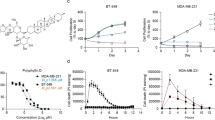Summary
Tetrazanbigen (TNBG) is a novel synthetic antitumor drug with significant antitumor effects on common solid tumors in vitro and in vivo. It may lead to death of cancer cells through a tumor-associated lipoidosis mechanism, and result in lipid droplets (LDs) accumulation at the cytoplasm. In this study, the effects of TNBG on protein expression in human hepatocellular carcinoma cell line QGY-7701 were studied for elucidating its antitumor mechanism. The proteins extracted from TNBG-treated human hepatocellular carcinoma cell line QGY-7701 were analyzed and compared with control cells by two-dimensional gel electrophoresis. The differential proteins were identified by matrix-associated laser desorption ionization time-of-flight mass (MALDI-TOF-MS) spectrometry. Two proteins of interest, the levels of which were significantly increased in TNBG-treated cells, were further characterized by Western blot analysis. The results showed a total of 846±23 spots in control cells and 853±30 spots in TNBG-treated cells. Twenty-six up-regulated or down-regulated proteins were found by analyzing differential proteomic 2-DE map. Eleven of them were identified by mass spectrometry. They were protein disulfide-isomerase precursor, 94 kD glucose-regulated protein, heat shock protein (HSP) 90-alpha, ATP-citrate lyase, HMG-CoA reductase, glucose-6-phosphate 1-dehydrogenase, very-long-chain specific acyl-CoA dehydrogenase, squalene synthetase, sterol regulatory element-binding protein 1, fructose-bisphosphate aldolase A, and peroxiredoxin-1. These up-regulated or down-regulated proteins are mostly related to lipid metabolism. The TNBG antitumor mechanism is probably to influence tumor lipid metabolism, resulting in accumulation of LDs in tumor cells.
Similar content being viewed by others
References
Yu Y. Preparation and use of a kind of azagonane compound. Chinese patent (Chinese), 1996. CN1124251
Li LJ, Yu Y, Tang WX, et al. Effects of TNBG on the proliferation and apoptosis of human hepatocellular carcinoma cell line QGY-7701. J Sichuan Univ (Med Sci) (Chinese), 2005,36:372–374
Li LJ, Yang XL, Yuan YH, et al. Changes of gene expression of human hepatocellular carcinoma cell line QGY-7701 induced by tetrazanbigen. Acta Academiae Medicinae Militaris Tertiae (Chinese), 2006,28:151–153
Hwang YY, Li MD. Protein differentially expressed in response to nicotine in five rat brain regions: Identification using a 2-DE/MS-based proteomics approach. Proteomics, 2006,6:3138–3153
Jiang D, Ying W, Lu Y, et al. Identification of metastasis-associated proteins by proteomic analysis and functional exploration of interleukin-18 in metastasis. Proteomics, 2003,3:724–737
Ramagli LS, Rodriguez LV. Quantitation of microgram amounts of protein in two-dimensional polyacrylamide gel electrophoresis sample buffe. Electrophoresis,1985,6:559–563
Bergquist J, Gobom J, Blomberg A, et al. Identification of nuclei associated proteins by 2D-gel electrophoresis and mass pectrometry. J Neurosci Meth, 2001,109:3–11
Neuhoff V, Arold N, Taube D, et al. Improved staining of proteins in polyacrylamide gels including isoelectric focusing gels with clear background at nanogram sensitity using Coomassie brilliant blue G-250 and R-250. Electrophoresis, 1988,9:255–262
Gerner C, Frohwein U, Gotzmann J, et al. The Fas-induced apoptosis analyzed by high throughput proteome analysis. J Biol Chem, 2000,275(50):39018–39026
Page MJ, Amess B, Rohlff C, et al. Proteomics: A major new technology for the drug discovery process. Drug Discov Today, 1999,4:55–62
de Crom R, van Haperen R, Janssens R, et al. Grp96/Grp94 is a putative high density lipoprotein-binding protein in liver. Biochim Biophys Acta, 1999,1437(3):378–392
Lan H, Rabaglia ME, Schueler KL, et al. Distinguishing covariation from causation in diabetes:a lesson from the protein disulfide isomerase mRNA abundance trait. Diabetes, 2004,53:240–244
Wetterau JR, Combs KA, Mclean LR, et a1. Protein disulfide isomerase appears necessary to maintain the catalytically active structure of the microsomal triglyceride transfer protein. Biochemistry, 1991,30(40):9728–9735
Eberle D, Hegarty B, Bossard P, et a1. SREBP transcription factors: master regulators of lipid homeostasis. Biochimie, 2004,86(11):839–848
Ccombs G, Westrop G, Suehan P, et a1. The Amitechondriate eukaryote triehomonas vaginalis contains a divergent thioredoxin-1inked peroxiredoxin antioxidant system. J Bio Chem, 2004,279(7):5249–5256
Beyer NH, Roepstorf P, Hammer K, et a1. Protcome analysis of the purine stimulon from Lactecaceus lactis. Proteomics, 2003,3(5):786–797
Li BH, Ma XF, Wang Y, et al. Structure-activity relationship of polyphenols that inhibit Fatty Acid Synthase. J Biochem (Tokyo), 2005,138:679–685
Scaglia N, Caviglia JM, Igal RA. High stearoyl-CoA desaturase protein and activity levels in simian virus 40 transformed-human lung fibroblasts. Biochim Biophys Acta, 2005,1687:141–151
Goldstein JL, Brown MS. Regulation of the mevalonate pathway. Nature, 1990,343:425–430
Jakobisiak M, Golab J. Potential antitumor effects of statins (Review). Int J Oncol, 2003,23:1055–1069
Author information
Authors and Affiliations
Additional information
This project was supported by grants from National Natural Sciences Foundation of China (No. 30772595, No. 3037163 2 and No. 30171070), National Foundation for New Drug Research and Development of China (No. 96-501-5-6), and Chongqing Municipal Sciences Technology Commission (Yu Ke Fa 20021425).
Rights and permissions
About this article
Cite this article
Yuan, Y., Li, W., Li, L. et al. Effects of tetrazanbigen on the protein expression in human hepatocellular carcinoma cell line QGY-7701. J. Huazhong Univ. Sci. Technol. [Med. Sci.] 29, 304–308 (2009). https://doi.org/10.1007/s11596-009-0308-9
Received:
Published:
Issue Date:
DOI: https://doi.org/10.1007/s11596-009-0308-9




